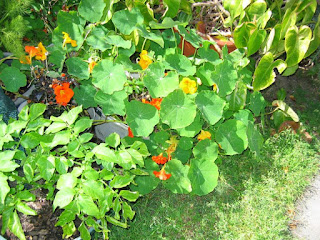I love the way the plant hangs and drapes itself in my garden, providing shade to the soil below, and assisting in the prevention of weeds.
Not only is the plant itself pretty, but it has various culinary uses too.
I have mixed the flowers in with my salad (please read the info / warnings on edible flowers here) and have been rewarded with a delicious peppery taste, and I have been told (although haven't tried it yet) that one can use the seeds in place of capers, and, according to James Wong (Grow your own Drugs ISBN 978-1-60652-107-6 page 208), one can can also use the flowers and leaves, which have antimicrobial properties, to treat bronchitis, catarrh and upper respiratory tract infections.
 |
| A nasturtium seed just waiting to be harvested |
According to Edible and Medicinal flowers by Margaret Roberts (page 56)nasturtiums are high in Vit C and are a natural antibiotic.
But, I thought today I would make some nasturtium capers and this is a recipe I found online (http://www.herbalgardens.com/archives/articles-archive/nasturtiums.html)
Pickled Nasturtium Seeds
Use green nasturtium seeds, and in picking retain a short length of stem on each. Lay the seeds in cold salted water for two days (two tablespoons salt to one quart water), then place them in cold water for another day. Drain and rinse well and place the seeds in a glass jar, cover with vinegar heated to boiling point, and close the jar tightly. In a few days the seeds will be ready to use. They are an excellent substitute for capers.
 |
| Nasturtiums - graceful, edible and beautiful |
 |
| 230gms of Nasturtium seeds harvested from my garden in just 10 minutes |
Separate the clusters of seeds, if they occur, and then remove the stalks and remaining bits of flowers from the seeds and wash well to remove any sand or insects.
 |
| They can occur as single seeds, double or triple seeds. Pull off the stalks, separate and rinse. |
Then I dissolved 1 tablespoon of salt into 500mls water (1 US quart = 0.946352946 litres and I'm doing 1/2 the quantity) and I added the seeds.
This is being allowed to stand for 2 days before rinsing - after which I will leave them in plain water for the last day. I will boil the vinegar (enough to cover the seeds) and pour it onto rinsed seeds in two separate small sealable bottles.
Even though they are being preserved in vinegar, I will definitely store one the "nasturtium capers" in the fridge. The other one will (possibly) be sacrificed to science / my preserving curiosity - I want to see how long it will last in my pantry cupboard.
 |
| Pickled Nasturtium capers |
They can be used in sauces, dips, casseroles, soups, stews and as edible decorations. For more recipes using capers go to: Home cooking
 |
| In addition I also get beautiful flowers and colour for my house - free from my garden |


.JPG)

Glad I found this site/blog.
ReplyDeleteI'm originally from SA but currently live in Israel. I see so many wild plants around ( weeds essentially) that look edible - nasturtiums are all over the place ! Going to try pickling the seeds Caper style and see what happens :)
Simon Peirson
Si - Welcome :-)
ReplyDeleteNasturium seeds, prepared and pickled as abopve, as known as poor mans' capers. Mine worked out brilliantly - so there is no reason why yours shouldn't :-)